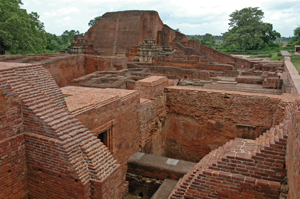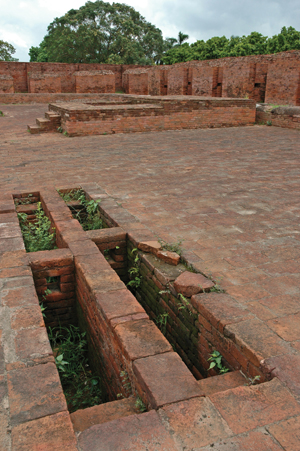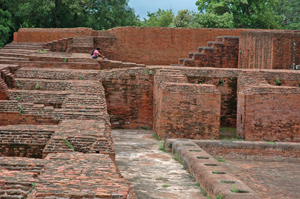|
In light of Nalanda March 2010
By: Namit Arora
Photos by Namit Arora

Journey to the West is "China's most beloved novel of religious
quest and picaresque adventure", according to historian Jonathan
Spence. Published in the 1590s during the waning years of the
Ming dynasty, the novel's hero is described by Spence as "a
mischievous monkey with human traits [who] accompanies the monk-hero
on his action-filled travels to India in search of Buddhist scripture."
The work represents an allegory of pilgrims journeying toward
India as individuals journeying toward enlightenment.
Intellectual foundations: Scenes of modern-day
Nalanda
The inspiration for Journey came from the travels of a seventh-century
Chinese man named Xuanzang (a name that has been rendered in various
ways over the centuries). Though raised in a conservative Confucian
family near Chang'an (modern Xian), at age 13 Xuanzang followed
his brother into the Buddhist monastic life, Buddhism having come
to China around five centuries earlier. A precocious boy, he mastered
his material so well that he was ordained a full monk when only
20. Disenchanted with the quality of Buddhist texts and teachers
available to him, he decided to go west (and eventually southwest),
to India, to the cradle and thriving centre of Buddhism. After
a yearlong journey full of peril and adventure, across deserts
and mountains, via Tashkent and Samarkand, meeting robbers and
kings, debating Buddhist scholars on the Silk Road and in Afghanistan
(where he saw the standing Buddhas at Bamiyan), Xuanzang reached
what is now Pakistan.
He spent 17 years, from 629 until 645, in the Subcontinent, travelling,
visiting places associated with the Buddha's life, learning Sanskrit
and studying with Buddhist masters. Most notably, Xuanzang studied
with the teachers at Nalanda University in modern-day Bihar, one
of the first great universities of the world, where subjects such
as grammar, logic, philosophy, metaphysics, astronomy, medicine
and theology were in the curriculum. His erudition seems to have
brought him fame and royal patronage in India. In a convocation
of religious scholars, Xuanzang is said to have defeated 500 Brahmins,
Jains and heterodox Buddhists in debate. The Nalanda establishment
greatly admired Xuanzang, and offered him a senior position on
their academic staff. But he is said to have declined with this
reply: "Buddha established his doctrine so that it might
be diffused to all lands. Who would wish to enjoy it alone, and
to forget those who are not yet enlightened?" Long thereafter,
he was accorded a place in Subcontinent's monastic iconography,
tellingly depicted with chopsticks, a spoon and hemp shoes, and
always sitting atop multicoloured clouds.
Before returning to China, Xuanzang gathered hundreds of Sanskrit
texts, relics, statues and other artefacts, loaded them on pack
animals, and set off for Xian across the Pamirs, by way of present-day
NWFP. For the remaining 19 years of his life, until 664, he worked
with a team of linguist monks, translating into Mandarin and writing
commentaries on many of the 657 books that survived his journey
(many others were lost when he crossed the Indus). When Buddhism
largely died out in the Subcontinent, its texts lost forever,
these translations became the only version of the originals. Xuanzang
also published an account of his travels, now an invaluable historical
and archaeological record.
Yi Jing's rambles

The Nalanda ovens
Xuanzang founded the Faxiang school of thought in China, whose
ideas live on in today's Zen Buddhism. It was based on the phenomenology
of the yogacara school of Mahayana Buddhism, focusing on consciousness
and suggesting that the world is a representation of the mind.
The Buddhist Tang emperor Gaozong supported Xuanzang's academic
enterprise, and even built a pagoda – now the Big Goose Pagoda
of Xian – to house his translations, which are displayed
in a small museum on site. Outside the entrance is an elegant
modern statue of the ancient trekker. It is said that the emperor
was so upset when he heard of the monk's death that he cancelled
all audiences for three days.
Xuanzang's death and grand funeral in Chang'an was likely witnessed
by Yi Jing, a younger admirer and Buddhist monk who had been inspired
by "the noble enthusiasm" of Xuanzang, and had for over
a decade wanted to follow in his footsteps to India. When he was
30 years old, Yi Jing became serious about his dream, found a
sponsor for his journey, and set sail on a Persian boat for the
kingdom of Srivijaya in Sumatra. He stayed for many months with
other foreign scholars, and learned Sanskrit. In the preceding
centuries, Indian merchants had not only brought Buddhism to Southeast
Asia but also a linguistic script, religious texts and rituals,
literature, art, architecture and countless other aspects of Indian
culture, immersion in which helped Yi Jing's preparation for India.
Arriving by sea in eastern modern-day India in 673, Yi Jing found
a group of merchants and priests heading for Nalanda. Travelling
by foot through a region said to be unsafe, he was struck down
"by an illness of the season" and could not keep up
with the group. (This information was subsequently recorded in
Yi Jing's writings, a translated version of which was published
in 1896 as A Record of the Buddhist Religion as Practiced in India
and the Malay Archipelago A.D. 671-695.) Finding Yi Jing alone,
some mountain brigands descended on him, stripped him naked and
snatched his belongings. Despairing and fearful of rumours that
suggested the locals enjoyed sacrificing fair-skinned people,
he writes, "I entered into a muddy hole, and besmeared all
my body with mud. I covered myself with leaves, and supporting
myself on a stick, I advanced slowly."
Sometime later, Yi Jing reached Nalanda, where he ended up studying
for ten years. He also travelled to the places associated with
the Buddha's life, such as Bodh Gaya, Sarnath and Kushinagar.
In all, he reported travelling to more than 30 `countries' in
the Subcontinent. He met famous teachers "renowned for their
brilliant character", and wrote, "I have always been
glad that I had the opportunity of acquiring knowledge from them
personally which I should otherwise never have possessed."
When he eventually left the region in 685, he carried back some
400 books, and translated many of them on a second, multi-year
stint on Sumatra. He died at age 79 and, like Xuanzang, was lavishly
honoured by the Tang emperor. In the wake of these two explorer-monks,
India, and Nalanda in particular, attracted a great many students
and scholars from all over Asia, including Sri Lanka, China, Tibet,
Persia, Indonesia, Japan and Korea.
Six-month fire

Students' quarters
Nalanda University arose in the early fifth century, during the
reign of Kumara Gupta, though references to precursor sites associated
with teaching and learning go back another thousand years, to
the time of the Buddha and Mahavira. Between Xuanzang and Yi Jing,
we have a compelling portrait of the university's curriculum,
the life of the monks, the buildings and the general features
of the community.
Nalanda was more like a school of higher learning than an undergraduate
college. Prospective students had to be at least 20 years old,
and submit to an oral exam for university entrance. They had to
demonstrate deep familiarity with a host of subjects, and with
old and new works in many fields. Only around a quarter of prospective
students were admitted, and even they were promptly humbled by
the calibre of their teachers and co-students. When Xuanzang visited
Nalanda, there were 8500 students and 1500 teachers in 108 residential
monasteries, which often had two or more floors. Excavations have
revealed exquisitely carved temples and a row of ten monasteries
of oblong red bricks directly across from a row of stupas in brick
and plaster. Rooms typically had chairs, wood blocks, small mats
and utensils stored in wall niches. Yi Jing approvingly wrote
that each year before the monsoon, the best rooms were awarded
to the eldest members in the community.
Some of the best teachers not only taught but also composed treatises
and commentaries, much as Xuanzang himself did later in life.
Many acquired great fame, and a Nalanda education held serious
cachet among the public. Teachers lived among the students in
the monasteries, common features of which included a podium for
lectures, a communal brick oven, bathrooms and a water well (often
in octagonal cross-section, supposedly inspired by the Eightfold
Path, one of the Buddha's central teachings). Water clocks guided
daily routines, and gongs were used to signal the start and end
of events, services and ceremonies. "There are more than
ten great pools near the Nalanda monastery," wrote Yi Jing.
"Every morning a ghanti is sounded to remind the monks of
the bathing-hour." For their daily exercise, the monks went
for walks in mid-mornings or late afternoons. Their dinner typically
included bean soup with butter, rice and vegetables, perhaps also
ghee, honey, sugar or a seasonal fruit such as mango.
For centuries, the university relied on royal patrons, including
the Guptas of Magadha, Harsha of Kannauj, and the Palas of Bengal.
Besides periodic endowments of land grants, money and livestock,
Nalanda also received tax revenues from over a hundred surrounding
villages, which paid for institutional essentials like food, clothing,
lodging and medicine for all students and teachers. But like most
things, all this too had to end, as Buddhism began to wane in
India after 800. By then, Hinduism had assimilated many of its
features – including vegetarianism, insider critiques of
the caste system, ending animal sacrifices – and embraced
the Buddha as the ninth avatar of Vishnu. A significant factor
in this was the ascendency of bhakti, or devotional Hinduism,
and its great appeal to the masses.
The Palas offered the last major royal support to Nalanda as
a centre of learning and the arts. In 1193, the university was
put to a brutal and decisive end by Bakhtiyar Khilji, a Turkish
Muslim invader on his way to conquer Bengal. He pillaged and burned
the monastery, killing perhaps thousands of monks. The shock of
this event lives on in local cultural memory to this day –
including the legend that the three libraries of Nalanda were
so large that they smouldered for six months.
Today, it is a sad irony of history that the present population
around Nalanda is mostly illiterate. Despite its beautiful landscape,
natural riches and awe-inspiring history – the land of the
Buddha and Mahavira, Ashoka and the Mauryas, and the cultural
effulgence of the Gupta age that invented the number zero and
the decimal system, created great art, drama and literature, and
furthered astronomy, mathematics and metallurgy – this region
harbours the poorest of the poor, a population that can hardly
grasp for knowledge and learning.
An ambitious project is now underway to develop a new international
university, also a residential school of postgraduate studies,
near the ruins of Nalanda. A consortium led by the governments
of India, China, Singapore and Japan plans to endow this institution
with a billion dollars. It will have a school of Buddhist studies,
philosophy and comparative religion; of historical studies; international
relations and peace; languages and literature; ecology and environmental
studies and more – all "aimed at advancing the concept
of an Asian community ... and rediscovering old relationships",
according to a May 2008 article. Some years down the road, perhaps
the modern-day contemporaries of Xuanzang and Yi Jing will arrive
in the plains of Bihar, seeking a place of learning and scholarship.
Namit Arora is a travel photographer, writer and creator of Shunya,
an online photo journal on India. He divides his time between
San Francisco and New Delhi.
http://himalmag.com/In-light
|